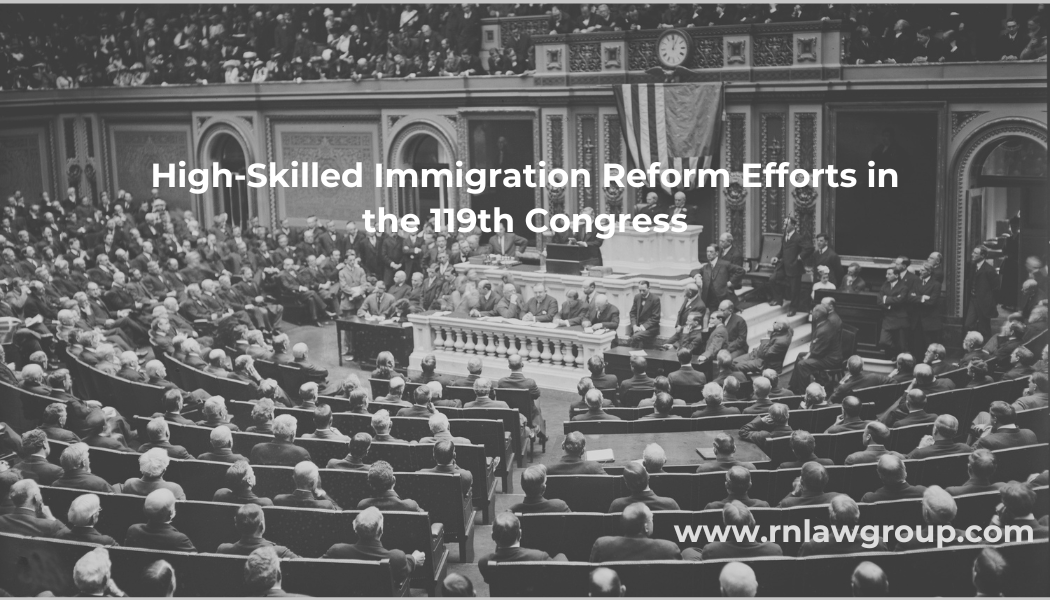
High-Skilled Immigration Reform Efforts in the 119th Congress
The 119th Congress has introduced two significant bills aimed at reshaping high-skilled immigration. These proposals reflect the ongoing national debate about the role of foreign workers in the U.S. economy, the balance between protecting American jobs, and ensuring employers can access global talent when needed. The two bills are the American Tech Workforce Act of 2025 (S. 2821) and the H-1B and L-1 Visa Reform Act of 2025. Notably, the H-1B and L-1 Visa Reform Act has not been published on Congress.gov as of this writing.
Both target the H-1B visa program, with the latter also addressing the L-1 visa. Together, they demonstrate very different approaches to reform, each with potential major implications for foreign national employees and U.S. employers.
The American Tech Workforce Act of 2025 (S. 2821)
Summary and Purpose
Introduced by Senator Jim Banks in September 2025, the American Tech Workforce Act is designed to dramatically alter the landscape of H-1B employment and international student work authorization. The bill reflects a belief among its proponents that the H-1B and student work programs are being used to displace U.S. workers and suppress wages.
Its headline features include a $150,000 minimum salary requirement for H-1B workers, the termination of the Optional Practical Training (OPT) program for international students, and a shift from a lottery to a salary-based allocation system for H-1B visas.
Key Provisions
- Elimination of OPT
The bill seeks to terminate the Optional Practical Training program, which currently allows F-1 students to work in the U.S. for up to one year after completing their studies (and up to three years for STEM graduates). Under this bill, all work authorization for F-1 students would end upon completion of their degree program. Pending OPT applications would be denied, and fees refunded. - $150,000 Minimum Salary for H-1Bs
Employers would be required to pay H-1B workers at least $150,000 annually or match the wage of a U.S. worker in a comparable role, whichever is higher. This wage floor would be indexed to inflation over time. This provision is designed to discourage companies from what is seen as hiring H-1B workers as a lower-cost alternative to U.S. workers. - Limitations on Third-Party Placements
H-1B visas would be restricted to one year if the worker is assigned to a third-party client site, with renewals contingent on specific, non-speculative assignments. - Salary-Based Allocation of H-1Bs
The H-1B lottery would be eliminated. Instead, visas would be allocated by prioritizing employers offering the highest wages. - Rule of Construction
The bill states explicitly that no federal agency may create work authorization programs unless authorized by Congress. This provision reinforces the termination of OPT and blocks future regulatory efforts to expand employment opportunities for foreign students or other categories without congressional approval.
Implications
For international students, the termination of OPT would be significant for those that had planned on using it. OPT currently provides a pathway to gain U.S. work experience and for some it serves as a stepping stone to H-1B sponsorship. Eliminating it could make the U.S. far less attractive as a study destination, pushing students toward countries like Canada, Australia, or the UK, which offer clear post-study work opportunities.
For foreign professionals, the $150,000 salary requirement would significantly narrow access to the H-1B program. Many employers would be unable or unwilling to meet this threshold, effectively limiting H-1B hiring to top tech companies or highly specialized roles.
For employers, this bill would drastically reduce flexibility in hiring foreign talent. Consulting firms and businesses that rely on third-party placements would be hit hardest.
Call to Action
The American Tech Workforce Act represents a highly restrictive vision for skilled immigration. Employers and employees alike should closely follow its progress and consider reaching out to their congressional representatives to share how changes to OPT or H-1B could impact their businesses, education plans, or careers. Sharing real-world experiences helps lawmakers understand the potential consequences of such sweeping reforms.
The H-1B and L-1 Visa Reform Act of 2025
Summary and Purpose
The H-1B and L-1 Visa Reform Act of 2025, reintroduced by Senators Chuck Grassley and Dick Durbin, takes a different approach. Rather than eliminating programs, it seeks to restore integrity to the H-1B and L-1 systems through stronger oversight, higher wage standards, and prioritization of highly skilled workers.
This bipartisan bill has been introduced in multiple Congresses since 2007, but has not been able to cross the finish line at any point.
Key Provisions
- Stronger Recruitment Requirements
Employers must demonstrate they have tried to hire U.S. workers before turning to H-1B sponsorship. Job postings would need to be listed on a Department of Labor website accessible to the public for at least 30 days, ensuring transparency and giving U.S. applicants a fair chance. - Non-Displacement Rules
Employers would have to attest that hiring H-1B or L-1 workers will not displace U.S. employees. This provision addresses concerns about companies replacing U.S. workers with lower-cost visa holders. - Wage Protections
The bill raises wage standards for H-1B workers to ensure they are paid more equitably. While it does not impose a flat $150,000 minimum like the American Tech Workforce Act, it requires employers to pay wages commensurate with market levels and skill. This discourages companies from hiring foreign workers primarily to save costs. - Merit-Based H-1B Allocation
The bill modifies the H-1B selection process to prioritize highly skilled applicants. Those with advanced U.S. degrees, especially in STEM, would be given preference. Jobs in shortage occupations and employers offering higher salaries would also be prioritized. - L-1 Visa Reforms
The bill tightens oversight of the L-1 program by limiting “new office” petitions to one year initially, requiring proof of genuine business operations. It also prohibits companies from using L-1s to displace U.S. workers and requires greater coordination between the Department of Homeland Security and State Department to prevent fraudulent use of L-1 visas. - Enhanced Enforcement
The Department of Labor would gain subpoena power and additional resources to investigate fraud and abuse. Employers found violating rules could face increased fines and potential bans from participating in the H-1B or L-1 programs.
Implications
For foreign workers, the reforms raise the bar but also improve protections. Those with advanced U.S. degrees and higher salaries would have a better chance of securing H-1B status, while others may face greater difficulty.
For employers, compliance obligations would increase. Companies must be prepared for audits, higher scrutiny, and potentially higher wage bills. However, firms that already operate in good faith may find themselves at an advantage, as the bill rewards responsible employers and prioritizes their visa petitions.
Call to Action
This bipartisan bill reflects a middle-ground approach: protecting U.S. workers while maintaining access to foreign talent where truly needed. Employers, employees, and students should track its progress and share their experiences with Congress. Whether you believe the reforms will help restore fairness or worry about unintended consequences, engagement ensures that lawmakers hear perspectives from both sides of the debate.
Conclusion
The American Tech Workforce Act of 2025 and the H-1B and L-1 Visa Reform Act of 2025 represent two competing visions for the future of skilled immigration. The former seeks to drastically curtail foreign work programs by eliminating OPT and imposing high wage thresholds, while the latter aims to reform and regulate existing programs to reduce abuse.
For international students, skilled foreign workers, and U.S. employers, the stakes are high. These bills could reshape how talent flows into the U.S. economy, affecting education choices, hiring strategies, and long-term workforce planning.
As these proposals move through Congress, it is important for all stakeholders to stay informed and engaged. Contacting congressional representatives, attending town halls, or simply sharing your perspective with community leaders can ensure that the real-world impacts of these bills are considered in the legislative process.
Immigration reform often moves slowly, but when bills like these surface, they shape the conversation. Employers and employees should take this opportunity to make their voices heard and help guide the future of high-skilled immigration in the United States.
By: Steven Brown
Steven A. Brown is a Partner at Reddy Neumann Brown PC, where he leads the firm’s Litigation Team, addressing delays and denials of immigration benefits, FOIA requests, and policy and regulatory challenges. Steven is dedicated to delivering practical and effective solutions for clients facing unreasonably delayed or unlawfully withheld immigration benefits, including Employment Authorization Documents (EADs), advance parole, green cards, 221(g) decisions, EB-5 delays, and other immigration-related matters. His litigation efforts were instrumental in Shergill, et al. v. Mayorkas, a landmark case that led to the U.S. government recognizing that under the INA, L-2 and E visa spouses are authorized to work incident to their status, eliminating the need for separate EAD applications. This case has transformed work authorization for thousands of families across the United States.

